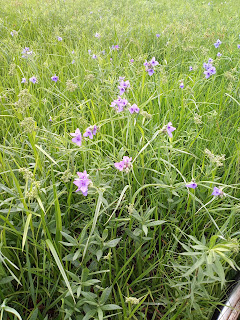Poirot Prairie Peers
Missouri is blessed with many beautiful relic/remnant prairies, each with its own unique "architecture" - some rocky, some sandy, others loamy; some wet, some dry and some a mixture of both. As many prairies as we have, it is important to remember that these represent less than 1% of the original tall grass prairie lands that once covered 30% of Missouri's surface (https://mdc.mo.gov/conmag/1996/03/tallgrass)
For more info about and directional maps to Missouri's public prairies, check out this handy link:
https://pages.wustl.edu/files/pages/imce/mnh/prairie_cons_areas.pdf
NOTE: only prairies owned by the Mo. State Parks, Mo. Dept of Conservation, the Missouri Prairie Foundation, or Nature Conservancy are listed and mapped. Privately owned prairies such as the Poirot Prairie do not appear in this on-line guide.
We (the local Poirot family) expect prairies located in Dade, Barton and Lawrence counties to be most comparable to that of the Poirot Prairie. If you would like to explore prairies in our near-vicinity, focus on those prairies numbered in the 50's-60's. Although a bit far away from the Poirot Prairie, Prairie State Park near Liberal, MO (see entry 43) is a true gem. If you are traveling along US71/I-49 and have a couple hours to spare, this park is worth a visit. For more detailed info on Prairie SP check out this link: https://mostateparks.com/park/prairie-state-park
Looking through the list of prairies mapped in the first link above, notice southwest Missouri has the highest number of prairies, as compared to other areas of MO. Lucky for us, the Poirot Prairie is in good company, being near some beautiful relics of southwest Missouri's prairie past.
One of the activities of the Poirot Prairie restoration process will be to evaluate prairie plant diversity, and to identify species that may have disappeared under 50 years of invasive plant pressure. The eco-structure and plant species found on these nearby prairies may be informative in this evaluation.
As I write this (March 24, 2018) there are signs that prairie plants will be greening up soon. Together with some Prairie Foundation members and expert plant identifiers, I look forward to walking the prairies, then sharing what we find/learn. Last week a preliminary look suggested we will see signs of new life in April. Yay!
Hey!
It's mighty quiet on this blog - no doubt the comment block was a factor. However, with help from cousin Eleanor Tiefenbrun, I have fixed the comments problem!! So, what would you like to see on this blog?
For more info about and directional maps to Missouri's public prairies, check out this handy link:
https://pages.wustl.edu/files/pages/imce/mnh/prairie_cons_areas.pdf
NOTE: only prairies owned by the Mo. State Parks, Mo. Dept of Conservation, the Missouri Prairie Foundation, or Nature Conservancy are listed and mapped. Privately owned prairies such as the Poirot Prairie do not appear in this on-line guide.
We (the local Poirot family) expect prairies located in Dade, Barton and Lawrence counties to be most comparable to that of the Poirot Prairie. If you would like to explore prairies in our near-vicinity, focus on those prairies numbered in the 50's-60's. Although a bit far away from the Poirot Prairie, Prairie State Park near Liberal, MO (see entry 43) is a true gem. If you are traveling along US71/I-49 and have a couple hours to spare, this park is worth a visit. For more detailed info on Prairie SP check out this link: https://mostateparks.com/park/prairie-state-park
Looking through the list of prairies mapped in the first link above, notice southwest Missouri has the highest number of prairies, as compared to other areas of MO. Lucky for us, the Poirot Prairie is in good company, being near some beautiful relics of southwest Missouri's prairie past.
One of the activities of the Poirot Prairie restoration process will be to evaluate prairie plant diversity, and to identify species that may have disappeared under 50 years of invasive plant pressure. The eco-structure and plant species found on these nearby prairies may be informative in this evaluation.
As I write this (March 24, 2018) there are signs that prairie plants will be greening up soon. Together with some Prairie Foundation members and expert plant identifiers, I look forward to walking the prairies, then sharing what we find/learn. Last week a preliminary look suggested we will see signs of new life in April. Yay!
Hey!
It's mighty quiet on this blog - no doubt the comment block was a factor. However, with help from cousin Eleanor Tiefenbrun, I have fixed the comments problem!! So, what would you like to see on this blog?


Comments